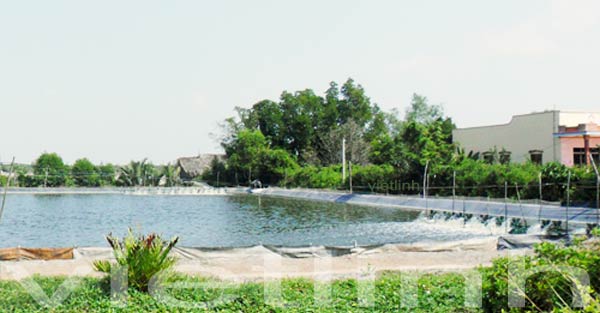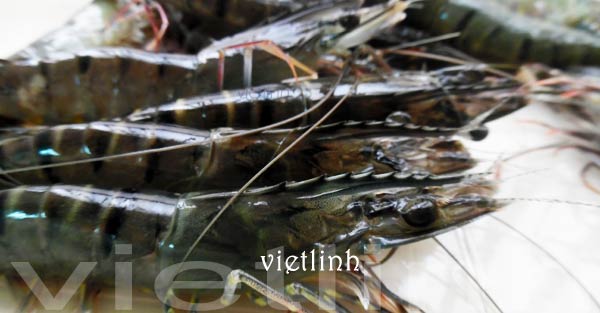Technological process for industrial black tiger prawn farming includes important steps such as preparing settling ponds, innovating farming ponds, managing water color, stocking post-larvae, taking care of shrimp, and harvesting. Note: Technological process for industrial black tiger prawn farming introduced in this article is for reference only.
Step 1. Prepare settling ponds
Pump saline or brackish water into settling ponds. Keep and treat water for 7-10 days to remove sediments and deposits. Disinfect, kill bacteria with chlorine 15-30ppm based on the process of using chlorine.
Step 2. Prepare farming ponds
2.1 Pond innovation: Remove all water from farming ponds. Clean up and move mud and organic sediments at the pond bottom to another area for treatment. Clean pond bottom; plow then flatten pond bottom.
2.2. Disinfect pond bottom with powdered lime with an appropriate dosage depending on soil pH of pond bottom. Dry pond for about 1 week, but do not have pond expose to excessive sunlight to prevent cracked soil.
2.3. Check and maintain aeration system and oxygen-supply system.
2.4. Pump treated water from settling pond into farming ponds. Water should be pumped through filter bags. Water height in farming pond should be 0.8-1.2 meters.

Step 3. Manage water color in farming ponds (creating a natural feed source in ponds)
7 days before stocking, apply DAP fertilizer and nutritious supplements (soybean, etc.) mixed with water. Apply this mixture to farming ponds daily until water transparency reaches a level of 0.3-0.4 meters.
Step 4. Stock shrimp post-larvae:
After preparing farming ponds, when criteria such as pH, salinity, water transparency and color meet the requirements, it is possible to stock shrimp. Post-larvae should have a size of Pl15 - Pl20. Post-larvae must be domesticized to adapt to pond water within 1-3 hours. Newly transported bags of post-larvae should be steep in farming ponds for about 15-30 minutes so that the temperature between water in post-larvae bags and in ponds is balanced. After that, pour shrimp post-larvae bags into a bucket; avoid having post-larvae stick to the bags; pour pond water into the bucket gradually, a little at a time. Mix and observe is shrimp post-larvae have adapted, then stock post-larvae into farming pond. Shrimp post-larvae not adapted will swim weakly on the surface of ponds.
Stand downwind and release shrimp post-larvae into ponds slowly. Avoid stirring pond water or make water turbid. After stocking, observe the dispersion ability of post-larvae in ponds. If post-larvae gather in groups, use hand or bucket to gently shake water to disperse them evenly into different positions in ponds.
After stocking shrimp, it is necessary to monitor the survival rate daily. Determine the number of post-larvae in each farming pond to adjust the amount of feed needed.
Post-larvae should be stocked during cool weather, preferably between 5-7 AM in the morning or 4 - 6 PM in the afternoon. Post-larvae should not be stocked when it is raining or raining heavily.
Stocking density depends on farming methods. On average, for improved extensive farming, stock less than 5 post-larvae/square meter. For semi-intensive farming, stock 10-20 post-larvae/square meter. For intensive farming, stock over 25 post-larvae/square meter. Stocking density must also be determined based on other factors such as shrimp size and crop time.
Step 5. Take care of shrimp ponds:
5.1. Feed: Feed supplier must provide farmers with a feeding guide, which includes:
- Frequency of feeding per day,
- Ratio of feed for each meal throughout the day,
- The amount of feed based on age and weight of shrimp,
- Ratio of feed in feeding tray,
- Times to check feeding tray.
Farmers can use growth-enhancing feed or supplements mixed with feed for shrimp.
Note: To avoid shrimp eating in dirty areas in ponds, when shrimp peel, reduce the amount of feed. Similarly, when shrimp is weak, sick, or water in ponds is dirty, reduce the amount of feed.
5.2. Check shrimp:
- Observe shrimp regularly, especially at night to monitor for abnormalities,
- Observe shrimp color,
- Check out parts such as legs and antennae
- Check carapace
- Check feed in digestive system
- Check the intensity of catching prey and other behaviors of shrimp.
- Periodically provide bacteriological tests and PCR tests.
- Check the average weight of shrimp; track shrimp weight gain and calculate the appropriate amount of feed. According to Viet Linh, we should check shrimp weight in the early morning when the weather is cool, or in the afternoon at 4 PM to 6 PM.

5.3. Test water:
- Check pH: 2 times/day (morning and afternoon).
- Daily check water clarity, dissolved oxygen content, salinity, and alkalinity.
- Weekly measure sulfate, ammonia, nitrate, nitrite, bacteria, and algae.
- Change water (partially) or treat water (using microorganisms, chemicals) when one of those measurement criteria is not satisfactory, such as large fluctuations in pH during the day, decreasing levels of water transparency.
- Use additional biological products to clean pond water and pond bottoms throughout the farming period.
5.4. Inspect ponds:
- Check banks, culverts, ditches, and nets preventing crab daily
- Clean feeding tray as well as algae and foam on water surface.
5.5. Use aerators:
Duration of oxygen supply and aeration using paddle wheel aerators increases with shrimp's age:
- For shrimp from 1 to 5 weeks of age: turn on paddle wheel aerators for 1 hour/day.
- For shrimp from 5 to 8 weeks of age: turn on paddle wheel aerators from 2 to 4 hours/day.
- For shrimp from 9 to 12 weeks of age: turn on paddle wheel aerators from 6 to 8 hours/day.
- For shrimp from 13 to 15 weeks of age: turn on paddle wheel aerators from 9 to 10 hours/day.
- For shrimp from 15 weeks of age to harvest: turn on paddle wheel aerators from 11 to 12 hours/day.
From Viet Linh’s experience, it is helpful to run aerators regularly at night on rainy days or on days without much sunlight. Duration of aeration also increases with shrimp age:
- 1st month: 4-8 hours/day
- 2nd month: 8-12 hours/day
- 3rd month: 12-18 hours/day
- 4th month: 18-24 hours/day
Step 6. Harvest:
Depending on the market, pond environment, and shrimp health, farmers can decide the time of harvest. Ideal shrimp weight for harvest is equal or more than 25 grams/shrimp.
Methods of harvesting shrimp include draining the ponds, netting shrimp, or using electric nets.
© 2000 Viet Linh
- Technological process for industrial black tiger prawn farming (Vietnamese)
- Shrimp farming during tropical depressions
- Some tips for shrimp farming with biofloc and semi-biofloc technology
- Super-intensive whiteleg shrimp farming in 2 stages
- Tags: black tiger prawn; post-larvae; shrimp; shrimp farming